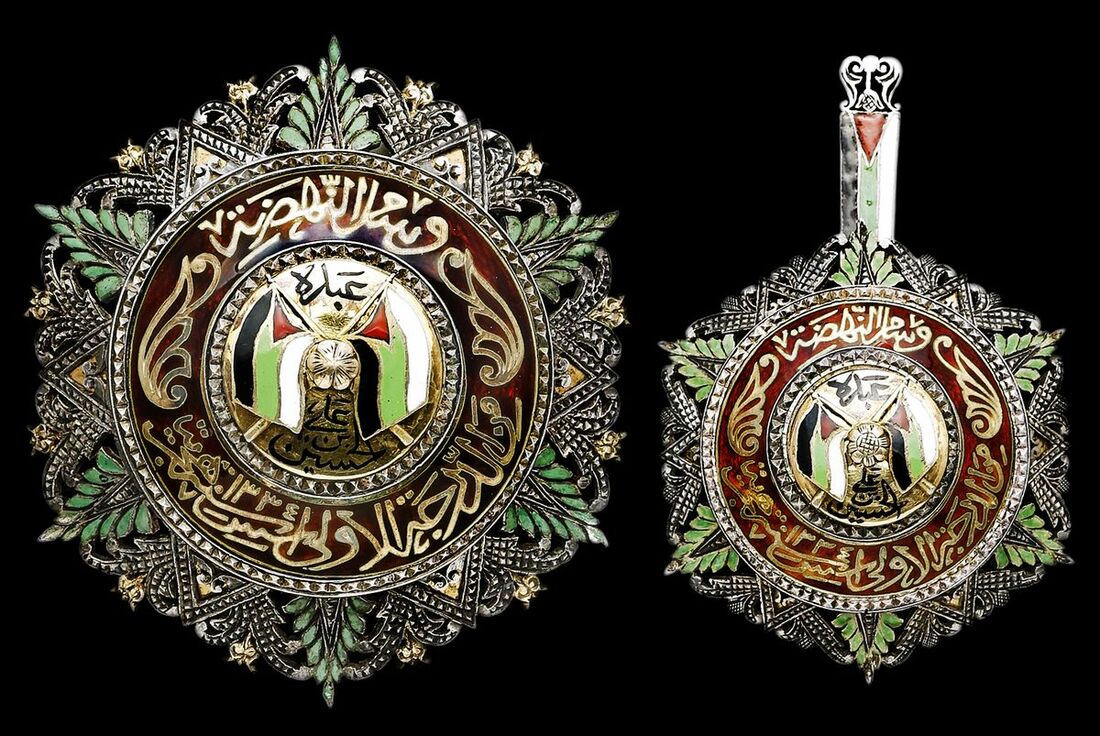Auction: 23002 - Orders, Decorations and Medals
Lot: 242
Hijaz, Kingdom (1916-25), Order of the Renaissance (Al Nahda), 1st Class set of Insignia, comprising sash Badge, 78mm including suspension x 50mm, gold, silver and enamel; Star, 73mm, gold silver and enamel, with two pins to reverse to aid wearing, good very fine and of the greatest rarity, with original woven sash riband and in cloth-covered case of issue (Lot)
Just six appointments of the 1st Class Order to British recipients. They were Lt. Col. Sir Henry McMahon, Admiral Sir Rosslyn Wemyss, Rear-Admiral Henry Pelly, Lt. Col. Cyril Wilson, Major-General Sir Lee Stack and General Sir Reginald Wingate.
The history of the Arab Revolt during the Great War is well documented but less well known are the details of the Order of the Al Nahda (Renaissance) which was bestowed by King Hussain Bin Ali of the Hijaz upon British subjects for their services during this period. In addition to the Order of Al Nahda King Hussein also instituted the Orders of Al Istiqlal (Independence). Initially little was known about these orders. The Foreign Office in London were, by the early 1920's, being asked for information concerning the awards - but having no information appealed to the then British Agency in Jeddah. A letter from the Foreign Office dated 31 December 1924 gives some insight:
'We are receiving inquiries from various quarters as to the origin and general history of the Orders of El Nahda and Istiglal of the Hedjaz. I find that the Foreign Office have themselves no particular information on the subject: hence my appeal to you. Could you perhaps kindly let us know anything you can about these orders, their history, origin, purpose for which they were instituted, and membership? We shall then be able to satisfy the curiosity of such different personalities as the Danish Minister and a representative of Spinks.'
At this time the Kingdom of Hejaz was in terminal decline and the acquisition of information was difficult. The response dated 28 February begins:
'To produce a complete reply to your letter of December 31st I needed a few details from the Hejaz Government, and as they have been more deeply interested in shells (not the conchologist's kind) than in decorations the last few weeks, I have kept the Danish Minister waiting.
The Order of the Nahda was established to commemorate the revolt of the Hejaz against the Turks. The first distribution was made on October 15th 1918, when Sharif Hussein declared himself King. It is supposed to be confined to people who actually took part in the revolt.
The colours are those of the Hejaz flag, viz. white, black, green and red. White, black and green have been the colours of the Arab movement since it began; the red was added by Hussein...If the kingship of the Hejaz should cease to exist, would there be a slump in these decorations, or would they, like a limited issue of postage stamps, become "rare" and expensive? It is always possible that Hussein would consider himself a sort of king "in partibus" and continue in that capacity to grant decorations.'
Indeed upon the incorporation of the Hejaz into Saudi Arabia in 1925 both orders became Trans-Jordanian awards and awarded by King Hussein's son Abdullah, later King Abdullah of Jordan and they now have become Jordanian awards. The Order itself displays the Hejira year 1334 (period 9 November 1915-27 October 1916 inclusive), in the centre two crossed Hijazi flags with a five-pointed star in the centre and the inscription 'His Servant Ali bin Al Hussein'.
British recipients of the Order of Al Nahda were published in the London Gazette, although other awards known to have been made were not promulgated. It appears that notice of awards were announced by the Arab Bureau in Cairo who acquired details as published in Al Qibla, being the Royal Hijaz Official Gazette. In most instances it seems that the Arab Bureau then forwarded the brevets and decorations to the responsible authority for onwards transmission to the recipient. The awards were announced on nineteen occasions between 24 October 1919 and 2 September 1924.
One of those whose name does not feature was T. E. Lawrence, 'Lawrence of Arabia'. It is thought that he was awarded the Second Class of Order of Renaissance, in recognition of his services to the Hijaz Government. His name is believed to have been listed in Al Qibla No. 320 of 9 Muharram 1339, corresponding with 7 October 1919. However as it is known that Lawrence had no time for awards and decorations, it is quite possible that he refused the Order.
With thanks to Owain Raw-Rees, whom the above notes have been compiled from his 2001 article.
Subject to 20% VAT on Buyer’s Premium. For more information please view Terms and Conditions for Buyers.
Sold for
£2,200
Starting price
£1800









